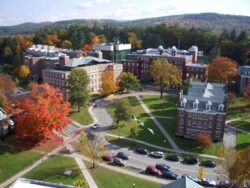Things You Should Know About New England Colleges
February 28, 2020 :: Admissionado
If you are planning to attend college in New England, get ready for fall colors like you’ve never seen them, clam chowder, lobster (“lobstah”), and a nice dose of Colonial-era history. New England needs no explanation to locals, but if you are from other parts of the country or abroad, you may find yourself a little confused by the region. Our college admissions consultants are here to help!
New England consists of six states: Massachusetts, New Hampshire, Vermont, Maine, Rhode Island, and Connecticut. Nope, New York is NOT a part of New England and New Englanders will thank you to remember that distinction. With that settled, let’s take a look at what else you should know if you are planning to attend college in New England.
Top-ranked schools with an emphasis on liberal arts
New England is blessed with a high concentration of excellent schools, and whether you are looking for a top-tier, world-renowned institution, an excellent engineering and STEM program, or a smaller school in an idyllic setting, New England has it all. It plays host to four of the eight Ivy League schools—Harvard, Dartmouth, Yale and Brown—and three of the top five schools in the country (according to the US News and World Report)—Harvard, MIT and Yale. In addition, New England has an exceptional number of excellent small liberal arts colleges, from Bowdoin in Maine to Middlebury in Vermont to Tufts, right outside of Boston. Whatever college experience you are looking for, New England has it in spades.
Boston
Considered by many, especially Bostonians, to be the capital of New England, Boston is a college town through and through. Not only does it have an exceptionally high concentration of schools, the entire city is pulsing with a young, student-friendly feel, truly a happy place for college grads. From Harvard Square to Kendall Square to Chestnut Hill, it seems like every neighborhood in the Greater Boston Area is the turf of a different college or university. This makes it an incredibly lively and fun place to be a student. But they’re aren’t just a lot of schools—some of them are among the best in the world. Harvard, MIT, Northeastern University, Boston College, Boston University, Tufts, Emerson—the list goes on. If you find the idea of attending school in Boston appealing, you’ll have your pick of great schools.
In addition to the institutional weight these universities bring, Boston is also home to many of the country’s great non-profit, artistic and research organizations, from the MFA to the New England Conservatory and the Boston Symphony Orchestra. The city has excellent hospitals and research facilities, and is a world-wide destination for people seeking new or experimental medical care. This opens up a wide array of opportunities for the city’s thriving student bodies to gain practical experience in their fields.

Small but exceptional
Outside of the Boston metro area, New England is dotted with excellent small liberal arts institutions, often in idyllic rural settings. New England colleges take four of the top six spots in the national rankings of the best liberal arts colleges, and seven of the top 15 spots (per USNWR). Some of those exceptional schools include Williams College and Amherst College, both in scenic western Massachusetts, Bowdoin College, along Maine’s unforgettable coast, and Middlebury College, deep in Vermont’s wooded mountains. These programs have gained a reputation for their excellence in liberal arts, and due to their small size, students at these schools benefit from an intimate program, personal access to top-notch faculty, and plenty of opportunity to step up to leadership positions and distinguish themselves.
Women’s Colleges
New England boasts a rich educational history—not only were the nation’s first colleges established there in the 17th and 18th centuries, the first women’s colleges were established there as well. At the time, this was because women were barred from other institutions—there were no co-ed higher education institutions until the mid 19th century. Now, however, while most schools have gone co-ed long ago, the women’s colleges that still exist today are concentrated where they first began, in New England. Smith College, Wellesley and Mount Holyoke are some of the region’s top-notch women’s colleges, all found in Massachusetts.
Historic charm
From the early pilgrim settlers at Plymouth Rock to Paul Revere’s famous ride, New England is the backdrop of many of America’s most early historic moments. The region is undoubtedly, and justifiably, proud of its rich history. While you might wonder how this could be relevant, the history of New England is a keystone of its culture, and you will be surrounded by reminders of it. Not to mention, it would be a shame not to take advantage of the Freedom Trail, Concord Hill, or the region’s many local history museums. We guarantee there will be some enthusiastic history buffs around!
Remarkable seasons
If you are attending college in New England, get ready for a remarkable college living experience with wondrous falls followed by long, cold winters. You’ve probably heard about the New England leaves—by the time October rolls around, the forests will be a cacophony of orange, red and yellow. While many regions offer pretty fall views, the variety and deep hues of the New England fall is unrivalled. Even if you are deep into your first semester papers and midterms, take time to get out into nature and appreciate the region’s natural splendor. On the flip side, come to school prepared with a hearty winter jacket and a good pair of winter snow boots—you’ll need them. And not just for a few months, either: winters are long in New England. The first snow falls surprisingly early, sometimes in early November, and huge Nor’easters continue dropping snow well into March and even early April.

Distinctive culture
There are plenty of other wonderful things to discover about New England culture, but perhaps most notable is its coastal lifestyle. New England borders the North Atlantic and generations of New Englanders have drawn their livelihoods and built a culture around the ocean. If you are picturing idyllic sandy beaches to get your tan on, though, think again. The North Atlantic is cold, and much of the coastline is rocky and rough, though very beautiful in its own unique way. The coast gives rise to New England’s proudest foodie gems, too, including world-class lobster and New England clam chowder. Even if seafood isn’t usually your cup of tea, to truly experience New England, you’ll want to give the cuisine a try.
New Englanders even have their own very distinct regional accent, which you’re probably familiar with from movies like The Departed and Good Will Hunting. If you thought those movies painted a caricature of the New England accent (surely real Bostonians don’t really talk like that?!), well, you’re in for a surprise. While not everyone has such a strong accent, you’ll hear plenty of dropped r’s and long, rounded “o’s” to make you feel as if you might just be walking around on the set of one of those movies. Alongside some unique New England slang like “wicked” (essentially meaning “very” or “extremely”), “jimmies” (sprinkles) and the “bubbler” (water fountain), you might find yourself feeling downright foreign for your first month or so. But don’t worry, you’ll soon pick it up, and when you return home you’ll be asking your family to pass the “clicker” (remote) and instructing them on how to drive around a “rotary” (a roundabout).
There are plenty of wonderful surprises and hidden gems to discover when you attend college in New England, so we won’t give them all away here. While you might initially be drawn to the great schools, and with good reason, you’ll stay for the historic charm, the unmatched falls, and the distinctive culture of New England.



